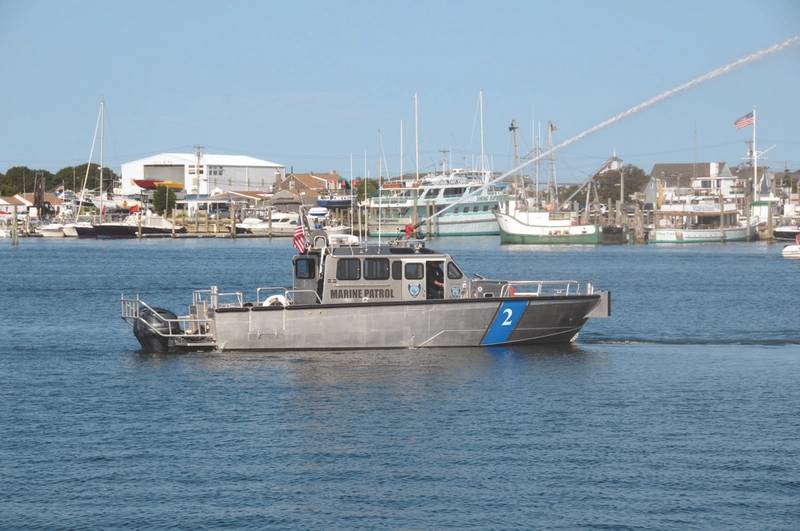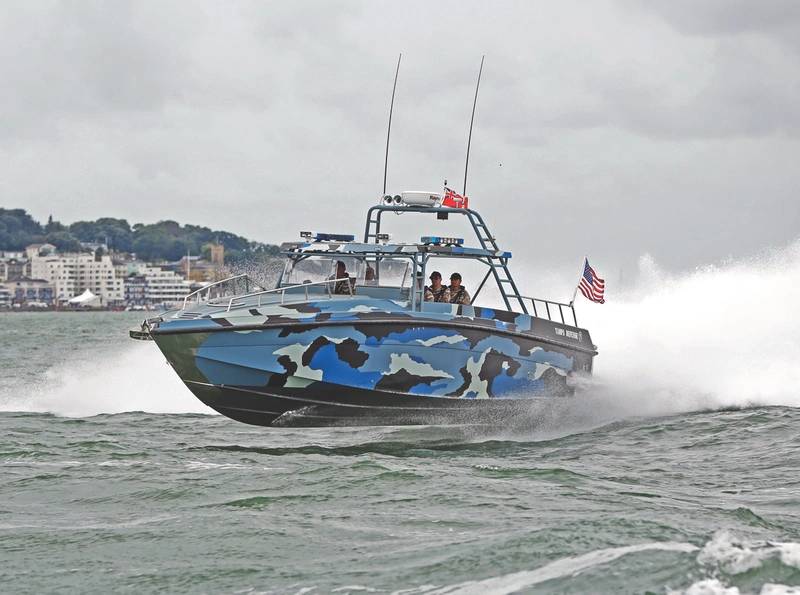Economics & Utility Redefine Today’s Workboat Output
GoM shipyards are meeting the demand for right-sized, multi-mission boats.
In the last decade, Gulf Coast shipyards have watched demand for multi-mission vessels grow from foreign governments and U.S. authorities. In particular, local counties and municipalities – pinched by shrinking budgets and expanding mission sets – began the march to leverage a single hull for more than one task. And, since these boats can serve military or civilian needs, the need for boatbuilders to quickly adapt a standard hull form to a particular requirement became a highly desired skill set.
“Interest in multi-mission vessels was seen in 2008 and became increasingly apparent in 2009 to 2010,” Robert Stevens, CEO of Tampa Yacht Manufacturing in Pinellas Park, Fla., said last month. “Before that, lots of governments weren’t particularly concerned with price. But because of geopolitical considerations, authorities have had far fewer resources to devote to the military and defense.”
In this case, the ‘geopolitics’ that Stevens alludes to highlights the influence of political and economic geography on a government. Globally, the economic recession from late 2007 to 2009 and longer in some nations was among the worst of the post-World War II downturns. And with terrorism on the increase in the past decade and continued piracy, governments have found that agile coastal vessels fit their tight budgets.
Closer to home, municipalities pooled their precious resources by using a single platform for SAR, patrol, command centers, firefighting, fish and wildlife management, spill response and much, much more. Cities and counties have had to watch their spending while protecting residents, and that’s boosted demand for multi-tasking vessels. This month, Marine News looks at how three Gulf Coast shipyards are meeting a growing appetite for these flexible, multi-mission workboats.
Tampa Yacht chooses materials and equipment carefully
“Our main focus is the design, engineering and construction of high-performance, multi-mission military vessels, with platforms offered from 10 to 21 meters in length,” Stevens said. “They’re custom configured for interception; interdiction; take-down; and VBSS--visit, board, search and seizure.”
Tampa Yacht produces the following boats, among others, represented by length in feet: 50MMP- Multi-Mission Platform; 44FCI- Fast Coastal Interceptor; 41MMP- Maritime Police Patrol; 40RHIB-EC- Rigid-Hull Inflatable Boat, enclosed; 36RHIB; 35SPC- Swat Patrol Craft; 35RHIB-EC; 34CCR- Combat Craft Riverine; and 73FCP- Fast Coastal Patrol.
In today’s economic arena, yards designing multi-mission military and paramilitary craft grapple with two basics – materials and equipment. “Cost, product history and worldwide availability guide our selections,” Stevens said. “We look to use commercial, off-the-shelf or COTS materials and equipment. We employ commercially available products, with proven quality history, and COTS equipment that can be serviced anywhere in world.”
Tampa Yacht uses a three-tier, product-sourcing policy for just in-time arrival of equipment and materials to meet its contract delivery promises. “Reliable and reputable materials and equipment provide a commonality to all our vessels and limit warranty exposure and equipment downtime,” Stevens said. Drawing from an established vendor base helps the company custom-configure mission needs for each client. “The challenge is to engineer each mission’s requirements, using commercial, off-the-shelf equipment and standardizing choices of materials to guarantee a quality product through repetitive manufacturing methodologies,” he said.
In 2015, Stevens had the privilege of meeting the First Sea Lord in England, the Royal Navy’s professional head and board chairman Admiral Sir George Zambellas. “In our meeting, he explained that, given the geopolitical environment, governments were confronted with severely curtailed military budgets, Stevens said. “That, coupled with the aging of the fleet’s legacy craft, would mean they’d need three boats now for the price of two, and each new vessel would have to carry out the missions performed by five craft previously.”
Swiftships: on cutting edge with its Corvette
“In years past, larger vessels were required for endurance, seakeeping characteristics, weapons platforms and advancements in technology,” Shehraze Shah, CEO at Swiftships Inc. in Morgan City, La., said. “More recently, a reduction in the footprints of major systems has enabled builders to construct smaller, more capable vessels.” Foreign militaries are moving to smaller platforms because of shrinking budgets and a need to save on fuel. “Demand has shifted from 5,000-ton ships to 1,500- to 2,000-ton vessels,” Shah said.
For over 50 years, Swiftships has built naval platforms, ranging from 25 to 55 meters. Vessels like its 75-meter, all-welded steel Corvette offer a user-friendly, multi-mission platform that can be scaled to meet a client’s needs for weapons, navigation-communication-sensor integration and crew size, Shah said. Unveiled last year, the 1,640-ton Corvette reaches a top speed of 26 knots and can be at sea for 25 days. Alternatively, it can be built with an aluminum superstructure, with a weight under 1,000 tons and a speed of 30 or more knots.
“Our Corvette, in the smallest class of rated warships, offers foreign government clients the most bang for their buck,” Shah said. “Taking its name from the Chevrolet model, this high-speed vessel can meet the needs of littoral and blue-water environments and can overcome conventional and asymmetric warfare challenges.” Its capabilities include coastal patrol, countering piracy and illegal trafficking, protecting EEZ resources, and conducting naval diplomacy.” The Corvette can accommodate a 60-member crew.
EEZs are exclusive economic sea zones, as prescribed by the United Nations Convention on the Law of the Sea. In these zones, a state has rights regarding the exploration and use of marine resources, including energy output.
“The Corvette offers a very low Total Ownership Cost or TOC of operation and sustainability,” Shah said. Middle Eastern and North African navies are eyeing the platform because of its flexibility, scalability, modularity and affordability. The vessel contains anti-air intelligence and reconnaissance with anti-surface missiles, and medium and small-caliber stabilized guns with a high rate of fire. It can carry a multi-role helicopter and unmanned aerial vehicles.
“Swiftships is working with the U.S. Department of State’s “Pol-Mil Bureau” to determine which weapons, sensors and multi-mission packages are releasable for clients to complete our final design,” Shah said. Under the Foreign Military Sales program, a country contracts with the U.S. Department of Defense for an American-made vessel. The State Department must approve the deal.
Silver Ships supplies patrol-fire response boats
In the U.S. market, multi-mission vessels are typically designed for any combination of fire-fighting, law enforcement, search and rescue, or emergency medical response. “Their effectiveness in service relies on the unique considerations of each mission in the build’s design phase and how well they’re merged together, without compromising the craft’s capability,” David Hunt, government business development manager at Silver Ships, Inc. in Theodore, Al., said.
Vessels built by Silver Ships include a delivered, 39-foot patrol-fire response boat for East Hampton, N.Y.; an in-production, 45-foot patrol-fire response boat for Baton Rouge, La..; and a delivered, 34-foot fire-emergency response boat for Islip, N.Y.
“The primary design challenge with these vessels is balancing the customer’s varied mission requirements and the equipment needed to perform those missions within the space and weight-carrying constraints of the craft,” Hunt said. Silver Ships liaises with its customers and end-users to see that all mission needs are integrated into a boat’s design and construction.
Multi-mission market: Highly Competitive, Domestically & Overseas
For Gulf Coast builders, the multi-mission business is full of contending yards from around the nation. “Competition to land any contract is often stiff,” Hunt said. Shah said for clients overseas, U.S. shipyards can end up competing with foreign companies that have no government scrutiny, but are eligible for government subsidies. “Foreign yards can offer designs and coinciding builds within about two years only,” he said.
“Not many U.S. shipyards want to get involved in building for foreign clients under FMS,” Shah also said. “These projects typically have a range of 24 to 40 months from the start of client discussions to the detailed-design award. The build time frame is about 36 months after design completion, with long lead items, particularly in the weapons and sensors suite.” But, U.S. vessels are still considered top quality in the international market, he said.
Gulf yards are capturing multi-mission business in a competitive arena. And with growing sales to diverse customers, they’ve moved well beyond supplying boats to offshore oil operators and the U.S. Navy and Coast Guard. As they do, builders are encountering a more diverse and savvy buyer, one with an increasing laundry list of mission requirements. That reality exists here at home, as well as across the ‘big pond.’
Finally, and like the U.S. merchant marine which today finds itself largely comprised of workboat sized tonnage (albeit for different reasons), the global market for military and law enforcement craft is steadily moving away from the previously ubiquitous 600-foot warship platform and instead embracing the smaller footprint of a faster, shallower draft, more versatile and capable hull. As they do, customers everywhere are discovering that U.S. quality in this sector is second to none, pricing is competitive, and the choices for models and missions; endless.
(As published in the October 2017 edition of Marine News)


